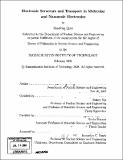| dc.contributor.advisor | Sidney Yip. | en_US |
| dc.contributor.author | Qian, Xiaofeng | en_US |
| dc.contributor.other | Massachusetts Institute of Technology. Dept. of Nuclear Science and Engineering. | en_US |
| dc.date.accessioned | 2009-03-16T19:42:28Z | |
| dc.date.available | 2009-03-16T19:42:28Z | |
| dc.date.copyright | 2008 | en_US |
| dc.date.issued | 2008 | en_US |
| dc.identifier.uri | http://hdl.handle.net/1721.1/44783 | |
| dc.description | Thesis (Ph. D.)--Massachusetts Institute of Technology, Dept. of Nuclear Science and Engineering, 2008. | en_US |
| dc.description | Includes bibliographical references (p. 239-256). | en_US |
| dc.description.abstract | Two approaches based on first-principles method are developed to qualitatively and quantitatively study electronic structure and phase-coherent transport in molecular and nanoscale electronics, where both quantum mechanical nature of electrons and dimensionality of systems play the critical roles in their electronic, magnetic and optical properties. Our first approach is based on Green's function method with ab initio quasiatomic orbitals within Landauer formalism. To efficiently and accurately apply Green's function method, we develop a minimal basis-set of quasiatomic orbitals from plane-wave density functional theory (DFT) results. This minimal basis-set resembles quasi-angular momentum characteristics in solid state systems and it further validates Slater's original idea of linear combinations of atomic orbitals. Based on their ab initio tight-binding matrices, the accuracy, efficiency and stability of our scheme are demonstrated by various examples, including band structure, Fermi surface, Mülliken charge, bond order, and quasiatomic-orbitals-projected band structure and quasiatomic-orbitals-projected Fermi surface. Remarkably these quasiatomic orbitals reveal the symmetry and chemical bonding nature of different molecular, surface and solid systems. With this minimal basis-set, quantum conductance and density of states of coherent electron transport are calculated by Green's function method in the Landauer formalism. Several molecular and nanoscale systems are investigated including atomic wires, benzene dithiolate, phenalenyl dithiolate and carbon nanotube with and without different types of defects. | en_US |
| dc.description.abstract | (cont.) Conductance eigenchannel decomposition, phase-encoded conductance eigenchannel visualization, and local current mapping are applied to achieve deeper understandings of electron transport mechanism, including spin dependence, dimensionality dependence, defect dependence, and quantum loop current induced by time-reversal symmetry breaking. Our second approach naturally arises due to the fact that electron transport is an excited state process. Time-dependent density functional theory (TDDFT) is a fundamental approach to account for dynamical correlations of wave functions and correct band gap in DFT. In our second approach, we mainly focus on the mathematical formulation and algorithm development of TDDFT with ultrasoft pseudopotentials and projector augmented wave method. Calculated optical absorption spectrum gives correct positions and shapes of excitation peaks compared to experimental results and other TDDFT results with norm-conserving pseudopotentials. Our method is further applied to study Fermi electron transmission through benzene dithiolate molecular junction sandwiched by two gold chains. It is first verified that group velocity of Fermi electron in the gold chain obtained by TDDFT agrees with that from band structure theory. Then under rigid band and zero bias approximations, a tiny Fermi electron wave packet from the chain is injected into the molecular junction. Transmission coefficient evaluated after the scattering process is around 5%. This is in agreement with the result from Green's function method. The two methods also show similar characteristic propagation channel. This nice agreement verifies that Green's function approach based on DFT reaches the TDDFT result without dynamical electron correlations in the linear response region. | en_US |
| dc.description.abstract | (cont.) With further development, our quasiatomic orbitals can serve as a minimal basis-set to combine non-equilibrium Green's function and TDDFT together with GW quasi-particle corrections. The unified method will provide a more accurate and efficient way to explore various molecular and nanoscale electronic devices such as chemical sensor, electromechanical device, magnetic memory, and optical electronics. | en_US |
| dc.description.statementofresponsibility | by Xiaofeng Qian. | en_US |
| dc.format.extent | 256 p. | en_US |
| dc.language.iso | eng | en_US |
| dc.publisher | Massachusetts Institute of Technology | en_US |
| dc.rights | M.I.T. theses are protected by
copyright. They may be viewed from this source for any purpose, but
reproduction or distribution in any format is prohibited without written
permission. See provided URL for inquiries about permission. | en_US |
| dc.rights.uri | http://dspace.mit.edu/handle/1721.1/7582 | en_US |
| dc.subject | Nuclear Science and Engineering. | en_US |
| dc.title | Electronic structure and transport in molecular and nanoscale electronics | en_US |
| dc.type | Thesis | en_US |
| dc.description.degree | Ph.D. | en_US |
| dc.contributor.department | Massachusetts Institute of Technology. Department of Nuclear Science and Engineering | |
| dc.identifier.oclc | 300300717 | en_US |
